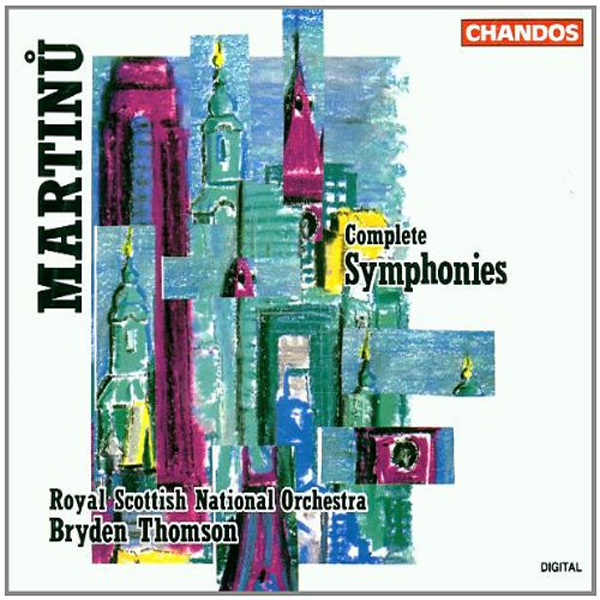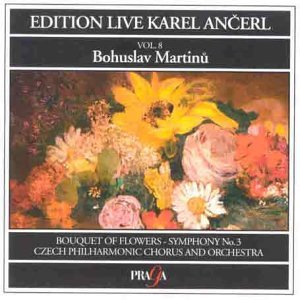A Survey of Martinů Symphony Cycles
An Index of ionarts Discographies
Martinů, A Love Affair
When getting a little better acquainted with Bohuslav Martinů, most people will start with the symphonies. They are his most prominent works and, apart maybe from the Second Violin Concerto and the neo-classical La revue de cuisine, the least seldom performed. Like so much music, they have an easier time communicating during a live event, but with a bit of concentration and a nice Scotch or other imbibement of choice at hand, they will yield their beauty, excitement, and vigor on record. As a group of symphonies, they are among the best the 20th century can offer; think Nielsen, Prokofiev, Honegger; even Shostakovich. (If you are missing Sibelius in this list, that's because I consider him a step above, still… perhaps the finest symphonist of the 20th century and in any case an unfair comparison to just about any other symphonist either side of him.)
The symphonies are also a good entry point, because they are all late works, which is, as Robert R. Reilly notes in Surprised by Beauty, “Martinů’s last magical period”. This way one avoids the heterogeneous previous styles for the introduction and, Reilly continues, “once captivated, [you can] work back through his earlier periods, which each contain masterpieces.” That is certainly true for the jaunty and lighthearted, piano-assisted de-facto Scherzo (“poco allegro”) of the Second Symphony. This is a most easily appreciable corker, even as some of the jolly ease seeps out a little before the finale (itself bright and merry) enters to carry this short crowd pleaser to its rambunctious end. The Third Symphony also has all the makings of an audience pleaser – if only an audience showed up when Martinů, too obscure for average concert-goers, is on the bill. The highlight-filled first movement – full of swinging rhythmic complexity – ends with a terrific bang. There’s a strong, timpani-motored lyrical surge in the middle movement, and the colorfully wily finale rouses even the drowsiest patrons. And, as if it needed another selling point, it’s no longer than a late Haydn Symphony! The touches of Janáček (i.e. Cunning Little Vixen) in the opening of the Fifth Symphony or the resolving chords of the Sixth that communicate the sun rising and spreading its fingers benevolently above all and sundry are musical equivalents of a wide smile.
American Symphonies
Martinů – a functional Asperger sufferer – was 51 when he wrote his first symphony in 1942 and around that time told his biographer “From now on, I’m going all in for fantasy.” To make the point unmistakable, he subtitled his Fourth Piano Concerto Incantations and his Sixth Symphony Fantaisies Symphoniques. The symphonic flowering of his last decade-and-a-half produced such masterpieces as the six symphonies, The Parables, Toccata e due Canzone, Les Fresques de Piero Della Francesca, and Estampes, all of which qualify as orchestral fantasias.” (Reilly, Surprised by Beauty) They are American Symphonies in the sense that they were all written in the US and – except for the Fifth – premiered by the Boston, Cleveland, and Philadelphia orchestras. For more on Martinů, see the chapter in Surprised by Beauty. See also the SBB Recommended Recordings section and this SBB CD review of Martinů’s Bouquet of Flowers.
Considering that all six symphonies amount to only about three hours of music (thereby fitting easily on three CDs), and that they are such major works, it might seem surprising that there are only seven complete cycles to-date (and none on the 'major' labels) – whereas there are already 12 (and more under way) of Vaughan Williams’ cycle of Nine or 21 of Shostakovich’s cycle of 15. As such, this discography took considerably less time to research and put together. Nevertheless, it's not likely to be mistake free. Hence my plea to generously inclined readers with more information and knowledge on the subject than I have to lend a helping hand correcting my mistakes or filling data-lacunae or broken links or oversights.
Almost-Cycles
There are several “Almost-Cycles” of Martinů’s symphonies; collections of most but not all the symphonies by one conductor. Since there are only seven complete cycles, it made sense to gather and introduce some of these, too. They all seem to have had at least vague intentions of becoming a cycle but for one reason or another didn’t. You will find them below the listing of the complete cycles.
Enjoy - and please comment either below or on Twitter.

Follow @ClassicalCritic

Václav NeumannCzech Philharmonic | |||
|---|---|---|---|
  The Symphonies Supraphon Release: 1989 3CDs US | UK | DE US | UK | DE |   The Symphonies Supraphon Japan Release: 2005? 3CDs US | UK | DE |   The Symphonies Supraphon Release: ancient LPs | |
Neeme JärviBamberg Symphony | |||
 The Symphonies BIS Release: 2003 3CDs US | UK | DE |  The Symphonies Brilliant Release: 2008 3CDs US | UK | DE |  The Symphonies Musical Heritage Release: 19?? 3CDs US | UK | DE | |
Bryden ThomsonRoyal Scottish National Orchestra | |||
  The Symphonies Chandos Release: 2005 3CDs US | UK | DE |   The Symphonies Chandos Release: 1992 3CDs US | UK | DE | ||
Arthur Fagen Ukraine National Symphony Orchestra | |||
  Symphonies 1 & 6 Naxos Release: 1997 CD 1 US | UK | DE |   Symphonies 2 & 4 Naxos Release: 2000 CD 2 US | UK | DE |   Symphonies 3 & 5 Naxos Release: 2001 CD 2 US | UK | DE | |
Vladimir VálekPrague Radio Symphony Orchestra | |||
  The Symphonies Supraphon Release: 1995 3CDs US | UK | DE | |||
Jiří BělohlávekBBC Symphony Orchestra | |||
   The Symphonies Onyx Release: 2011 3CDs US | UK | DE | |||
Cornelius MeisterVienna Radio Symphony Orchestra | |||
 The Symphonies Capriccio Release: 2017 3CDs US | UK | DE | |||
Incomplete Cycles | |||
Karel Ančerl [1, 3, 5, 6]Czech Philharmonic | |||
  Symphonies 5 & 6 K.A. Gold Ed. v.34 Supraphon Release: 2004 1CD US | UK | DE |   Symphony No.3 + Bouquet of Flowers Praga Release: 1996 1CD US | UK | DE |   Symphonies 1, 3, 5 (oop) Multisonic Release: 1995 1 CD US | UK | DE | |
Gennady Rozhdestvensky [2, 3, 5, 6]USSR Ministry of Culture Symphony Orchestra | |||
 Symphonies 2 & 3 Yedang Classics Release: ???? 1CD US | UK | DE |  Symphonies 5 & 6 Russian Revelation Release: ???? 1CD US | UK | DE | ||
Claus Peter Flor [1, 2, 5, 6]Berlin Symphony Orchestra VEB Schallplatten/RCA | |||
 Symphonies 1 & 2 RCA Release: 1990 1CD US | UK | DE |  Symphonies 4 & 6 RCA Release: 1988 1CD US | UK | DE | ||
Jiří Bělohlávek [1, 4, 6 +]Czech Philharmonic Chandos | |||
 Symphony 1 + Double Concerto H. 271 Chandos Release: 1991 2CDs US | UK | DE |  Symphony 4 + Field Mass et al. Chandos Release: 1993 1CD US | UK | DE |  Symphony 6 + Janáček & Suk Chandos Release: 1990 1CD US | UK | DE | |
Jiří Bělohlávek [1, 3, 4, 5, 6] / Czech Philharmonic Video CycleCzech Philharmonic Supraphon | |||
 Symphony 1 + What Men Live By Supraphon Release: 2018 1CD US | UK | DE |  Symphonies 3 & 4 Supraphon Release: 2003 1CD US | UK | DE US | UK | DE |  Symphonies 5 & 6 Supraphon Release: 2009 1CD US | UK | DE US | UK | DE | |
 Symphonies 1 - 6 Unitel / Carnegie Release: 2018 streaming only? No.1 | No.2 | No.3 | No.4 | No.5 | No.6 | Docu |
|||






















































6 comments:
jfl:
Thank you for this survey of recordings of Martinů Symphonies - I know most of these and in most cases concur with what you say.
As you are enthusiastic as I am about the performances conducted by Karel Ančerl, you might like to hear his performance - I believe the only one he gave - of Symphony No 2, recorded in the BBC's Maida Vale Studio with the Czech Philharmonic, leader Bruno Belčík, on 2 March 1962. The sound qulaity is not good - I hope someone issues the performance commercially in better sound at some time - and also the other work in the concert, Vaughan Williams Tallis Fantasia. I hope this linke works for you:
https://www.mediafire.com/#ewed3dbkvb6wd
Thanks for the comment and the hint re: Ancerl. I wonder if there will ever be a master tape that turns up.
Oh my God! I came to late to this, could be possible a new link for this Martinu Second by Ancerl, please?
The ČF recording of the First with Bělohlávek was actually the start if a new cycle in 2016-8. Bělohlávek conducted the Fourth - his fifth recording of it - and Jakub Hrůša conducted the rest after Bělohlávek's death. Joint project by Unitel and Czech Television. The best cycle yet in my opinion. Unitel will issue them as DVD and Blueray in 2024 but they can be viewed online on Czech Television and myfidelio.at.
Myfidelio now defunct but they are on carnegie hall + which is accessed via apple app outside US
Thanks so much for filling in this information. I've taken it into account for the update!
Post a Comment